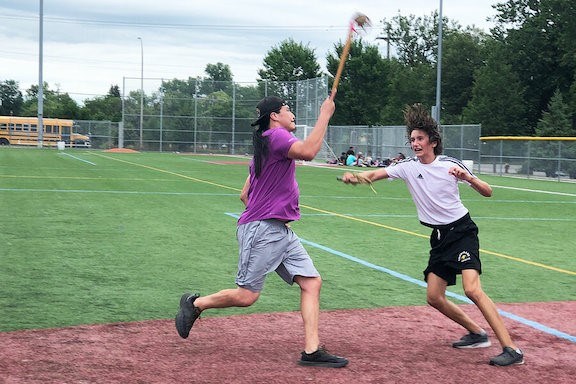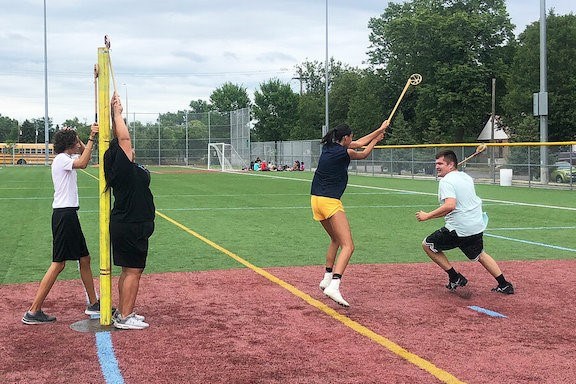REPRINTED WITH PERMISSION FROM THE CHRISTIAN SCIENCE MONITOR
 Chris Knutsen (left) makes his way to the end of the field with the ball during a pickup game with the TC Native Lacrosse team in St. Paul, Minnesota, on Aug. 7, 2022.Collette Davidson
Chris Knutsen (left) makes his way to the end of the field with the ball during a pickup game with the TC Native Lacrosse team in St. Paul, Minnesota, on Aug. 7, 2022.Collette Davidson
David Bezh Butler holds a shell bowl the size of a coconut in his palm, a fine line of smoke from burning herbs swirling into the air. One by one, he passes it among the 15 players of the Twin Cities Native Lacrosse team circled up on the Oxford Community Center field.
“This is for anyone who is bringing anything extra to the game,” says Mr. Butler, a self-described elder at the pickup match, as he leads the smudging ritual. “Whatever energy you bring to the game is what you get back.”
This ceremony, performed before each game, does more than set a mindful tone. It’s integral to what community lacrosse stands for here in the Twin Cities – home to one of the largest urban populations of American Indians in the country: healing and building community.
Unlike its modern, competitive counterpart – and its stereotypical “preppy, East Coast” image, according to players here – community lacrosse is not about who wins. Tribal teams participate in the competitive variety too, but here in the Twin Cities, the community game is about respect and having fun. The “Creator’s game,” as it is referred to within the community, can be played in celebration – to honor a family member’s college graduation – or in prayer for someone struggling with health issues.
Though lacrosse is one of the fastest-growing sports in the United States among young people, many are unaware of the Native origins of the game. But there is a growing movement within Native communities in parts of the U.S. and Canada to remedy that, by reclaiming it and then educating a wider public about its origins. Gaining more agency over a sport that has been colonized and re-appropriated is one way that Native communities are reasserting their identities and building cultural resilience.
“I think the majority culture should be informed about the origins of the sport,” says Anton Treuer, a professor of Ojibwe language and culture at Bemidji State University in Minnesota. “They should acknowledge [it] at collegiate events and use it as an opportunity to leverage attention to the history and the often marginalized Indigenous communities that shared it with the world.”
“At the same time, Native people should be encouraged and empowered to revitalize the Indigenous form of lacrosse and all of its cultural teachings and healing modalities.”
 Community lacrosse is not about keeping score, but players still try to get the ball down to the end of the field and throw it at the goal post in a game on Aug. 7, 2022, in St. Paul, Minnesota.Collette Davidson
Community lacrosse is not about keeping score, but players still try to get the ball down to the end of the field and throw it at the goal post in a game on Aug. 7, 2022, in St. Paul, Minnesota.Collette Davidson
Physical and spiritual
The scarcity of data means that the origins of lacrosse are unclear, but the game is thought to date back to A.D. 1100, when it was played by the Haudenosaunee, an alliance of six nations from the Mohawk, Oneida, Seneca, Onondaga, Cayuga, and Tuscarora tribes, spanning Canada and the northeast region of North America that have historically (and somewhat derogatorily) been known as the Iroquois Confederacy.
While early accounts show that the game was played similarly to war – to settle disputes between communities or tribes – it was also played for enjoyment or as a medicine game.
“Lacrosse served multiple purposes. ... It has cultural and sacred dimensions,” says Mr. Treuer. “The healing happens on multiple levels. There are physical, emotional, and spiritual modalities.”
The traditional stickball game can take three basic forms – the Iroqouian, Great Lakes, and Southeastern – which differ in equipment and stick-handling techniques. The modern, competitive game most closely resembles the Iroquoian game, whose stick ended with a large, triangular net, versus the Great Lakes version – the one played in the Twin Cities – which used a stick with a round, closed net pocket and deer hide-wrapped ball.
The modern, competitive game of lacrosse, by contrast, in which players wear protective padding, employs sticks up to 6 feet long and a rubber ball, which players use to catch, carry, and shoot into the opposing team’s goal. Although it is one of the fastest-growing sports on U.S. college campuses, and 69 countries are represented within World Lacrosse (the international governing body), lacrosse has not been included in the Olympic Games since 1908.
One of the many teams looking to change that is the Haudenosaunee Nationals men’s lacrosse squad. The team finished third at the last two world championship competitions and says it is the only Indigenous team in any sport to compete at that level.
But the Nationals have bumped up against administrative hurdles in some international competitions. While the Haudenosaunee have their own passports, their members come from parts of Ontario and upstate New York.
“There were questions about, are we a legitimate participant? Are we a country? It’s been interesting to engage with governments, who are not fully cognizant of our status,” says Leo Nolan, the executive director of the Nationals.
And though the team plays the modern version of the game during competitions, it tries to retain the traditional, community aspect of the original activity. Oren Lyons, the team’s faith keeper, helps the team maintain spirituality and peace by performing a ceremony with tobacco before each game as a way of “reaching to the Creator,” says Mr. Nolan.
“It’s important for all of us to understand what lacrosse was originally about,” says Mr. Nolan. “Now over the course of time, lacrosse has moved on to a more contemporary game, but it doesn’t mean we don’t respect what the Creator gave us. One of our responsibilities is to share this game with others.”
Still, some players are ambivalent about advertising the intricacies of traditional styles of lacrosse to a wider public, due to the way Indigenous people’s cultural traditions have been erased in the past.
“Many cultural holders don’t want to share their practices because they feel like they will be attacked again, and there’s been a long history of control and repression,” says Janice Forsyth, associate professor of sociology and the director of Indigenous Studies at Western University in London, Ontario.
“There are others who want to say, ‘Hey, we’ve survived and we’re still here.’ ... Communities will decide whether it’s important to revive their own ball-and-stick game and decide who they want to be.”
“Learn the history”
Out on the pitch at the Oxford Community Center, players from the TC Native Lacrosse team gather at the sidelines for a midmatch water break. The team includes people of all tribes, but the game focuses primarily on Ojibwe and Dakota traditions. Mr. Butler, who ran today’s game, says he hopes lacrosse can become as accessible as soccer or basketball. “You get some sticks, a ball, and a couple of people and it’s a game.”
Mr. Butler has taken his community lacrosse know-how to South High School in Minneapolis, where he runs the All Nations Program, an academic curriculum designed for American Indian students. He’s gotten an informal lacrosse group together and has been teaching students how to make their own sticks.
“It’s important for them to know how and why you do it,” he says, “and to learn the history.”
For Chris Knutsen and Alexandrah Walker, lacrosse is especially meaningful – they met at a pickup match and got engaged six years later to the day. Mr. Knutsen, who has played both modern and community lacrosse, says he approaches the two games differently.
“When I play modern lacrosse, it’s more competitive and I’m hard on myself,” he says, tossing a ball made of deer hide during a water break. “With the community game, I feel more happy and uplifted. It’s OK to make mistakes.”
Ms. Walker did her undergraduate thesis on lacrosse’s power to heal trauma and wants to continue teaching the game to others.
“For a long time I didn’t want to play, but now I always have sticks; we give them away to encourage people to play,” says Ms. Walker, who says lacrosse sticks are an extension of self, each one with its own spirit.
“It’s our game. Every tribe has its own story. We’re trying to reclaim and revitalize it, ... the Creator’s game. We want to take it with us everywhere we go.”
Related stories
Page created on 8/30/2022 10:35:07 PM
Last edited 8/30/2022 11:04:30 PM
